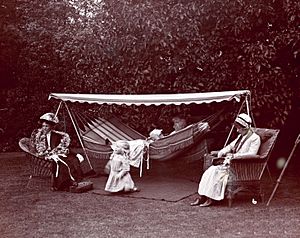Edith Marian Begbie facts for kids
Edith Marian Begbie (born February 8, 1866 – died March 27, 1932) was a brave suffragette. Suffragettes were women who fought for the right to vote. Edith was a member of the Women's Social and Political Union (WSPU), a group that used strong actions to get attention for their cause. In 1912, she went on a hunger strike while in Winson Green Prison in Birmingham. Because of her actions, she was given the WSPU's special Hunger Strike Medal.
Edith's Early Life
Edith Marian Macfarlane was born in 1866 in Leith, Scotland. She was the oldest of at least twelve children. Her parents were Marian Elizabeth Newton and John Macfarlane. Edith's younger sister, Florence Macfarlane, also became active in the fight for women's voting rights.
Their father, John Macfarlane, worked in a family business that made wire products and paper. As his businesses grew, he started a liberal newspaper. His belief in fairness and freedom might have influenced his daughters to stand up for what they believed in.
In 1888, Edith married John Aitchison Begbie, a merchant. They moved to Stanmore in England and had four children: George, Thomas, William, and Hilda.
Fighting for Women's Rights

After her husband passed away, Edith Begbie became very active in the suffragette movement. She was first arrested in 1910 during a protest known as "Black Friday." However, the charges against her were later dropped.
In 1911, she took part in the "No Vote no Census" protest. This was a way for suffragettes to show that if they couldn't vote, they wouldn't fully participate in the national census. Edith gave her name but refused to share more information.
On March 7, 1912, Edith was arrested again. She was accused of breaking windows along The Strand in London. She had hidden something in her hand warmer to do this. A witness said she walked down the street, breaking one window after another. This caused about £40 worth of damage.
When she appeared in court, Edith explained her actions. She said, "I stand here as the mother of four children... that my children should have equal rights and protection, daughters and sons." She felt that if men wouldn't listen to reason, she had to use stronger methods to make her point.
While in Winson Green Prison in Birmingham, Edith went on a hunger strike. She did this with Gertrude Wilkinson and her sister Florence Macfarlane. Refusing to eat was a way to protest their imprisonment and the government's refusal to grant women the vote.
After they were released from prison, both Edith and Florence were not well. Florence continued her strong protests for women's suffrage. However, Edith Begbie was not arrested again after this time.
The photograph shows Edith Begbie on the left, Gertrude Wilkinson in the middle, and Florence Macfarlane on the right. The child kneeling is Paul, the son of Rose Emma Lamartine Yates. The picture was taken at Rose Yates's home in Merton Park around 1912. Edith Begbie was a leader in the WSPU group in Wimbledon.
Edith Marian Begbie lived at 107 The Ridgeway in Wimbledon. When she passed away in 1932, she left behind a sum of £3,045 9s 7d.


